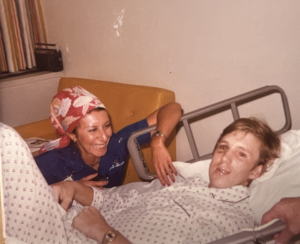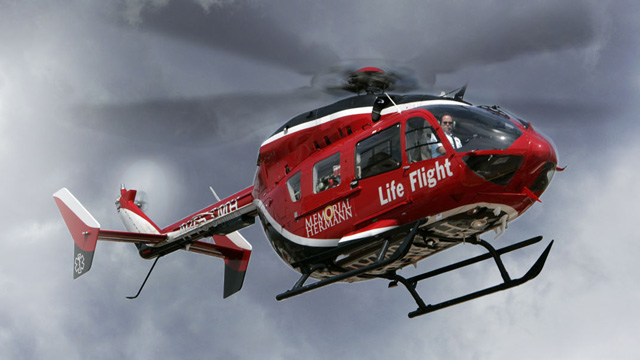Most people go their whole lives without having the kind of catastrophic medical emergency that puts them in a Memorial Hermann Life Flight® helicopter. Brian Bremser has had two.

Now an insurance agent in his hometown of Wharton, Bremser was transported by Life Flight again after he was seriously injured in a fall from a fishing boat. He had climbed on top of the boat to secure a flap and then fell head-first onto the pavement. Once again, he was transported by a highly skilled medical crew who could get him the care he needed quickly.
When Life Flight celebrated its 46th anniversary in 2022, Bremser returned to the helipad atop Memorial Hermann-TMC to thank the crew who’d saved his life for the second time.
“You’re looking a lot better than the last time I saw you,” said Life Flight pilot Jeff Johnson, shaking Bremser’s hand.
“Amen, brother,” Bremser said. “Hey, this time I didn’t bleed all over the place. Which is a good thing, right?” Johnson agreed.
Bremser is one of more than 400 patients Life Flight assists each month in the Greater Houston area. Since it began operating with a single helicopter on August 1, 1976, the critical care medical transport service has flown more than 158,000 missions .

The first 60 minutes following a traumatic injury are critical to a patient’s survival, explains Tom Flanagan, former vice president of Memorial Hermann Life Flight and System Trauma Services, who was involved with the Life Flight program for 35 years, starting as a flight nurse.
“It’s called the ‘golden hour’ in trauma care. If you can get the patient to definitive care within the first hour, you drastically decrease mortality and morbidity. And that clock starts when the injury occurs — not when the first responders arrive,” Flanagan said. “The genesis of that finding was during the Vietnam War, when medics saw that if you could get a helicopter to an injured soldier right where he was injured, airlift him out and start providing care right away, you had dramatically better outcomes. And if it worked in the battlefield, why wouldn’t it work in the civilian world?”
It did, and patient outcomes have only improved in the decades since Memorial Hermann Life Flight was founded by the late trauma surgeon James “Red” Duke, who died in 2015. In the 1990s, Life Flight began operating from four different community bases around the Houston area — Spring/Tomball to the north, Baytown to the east, Brazoria County to the south and Katy to the west — in addition to its home base at the Texas Medical Center. Those community bases meant Life Flight crews could reach patients even faster. And in recent years, specialized refrigerators allowed the helicopters to start carrying blood products, enabling medics to treat blood loss before reaching a hospital. “That’s made a huge difference,” Flanagan said.
The medical teams who work aboard Life Flight see people in the worst moments of their lives, but they give them their best chance to make it through those moments. “It’s very intense — very labor intensive and very emotionally intensive. You really have to have a passion for it,” Flanagan said. “One of the benefits is that a lot of the patients and their families come back years later to see us or send us thank you notes and pictures of how well they’re doing. It’s extremely rewarding.”
Memorial Hermann operates Life Flight as a community asset, without support from government or other funding sources. “When Dr. Duke started this program, he was very clear that this program was part of Memorial Hermann’s unwavering commitment to the community,” Flanagan said. “It’s there for the community when the need is there.”
And for people like Bremser, who are injured in a remote area, far from a hospital, Life Flight is often their only chance to reach the care they need in time. He knows how lucky he is to have had that chance. “These guys are great,” he said while visiting the medical team at Memorial Hermann-Texas Medical Center this month. “They got me here, and here I am. For the second time.”
Bremser was upbeat on the helipad this time around, balancing on one leg to demonstrate how well he had recovered. “Thanks for saving my life. Again,” he said, hugging the crew.
“We don’t want to see you in here a third time,” said Johnson, pointing to the helicopter’s cabin. “If we do, you better start playing the lottery, I’m telling you.”

Donate to Memorial Hermann Life Flight
Please consider making a donation to Memorial Hermann Life Flight. No matter which area of the mission you support, your gift will make a lasting impact on patients and their families.
Donate Now